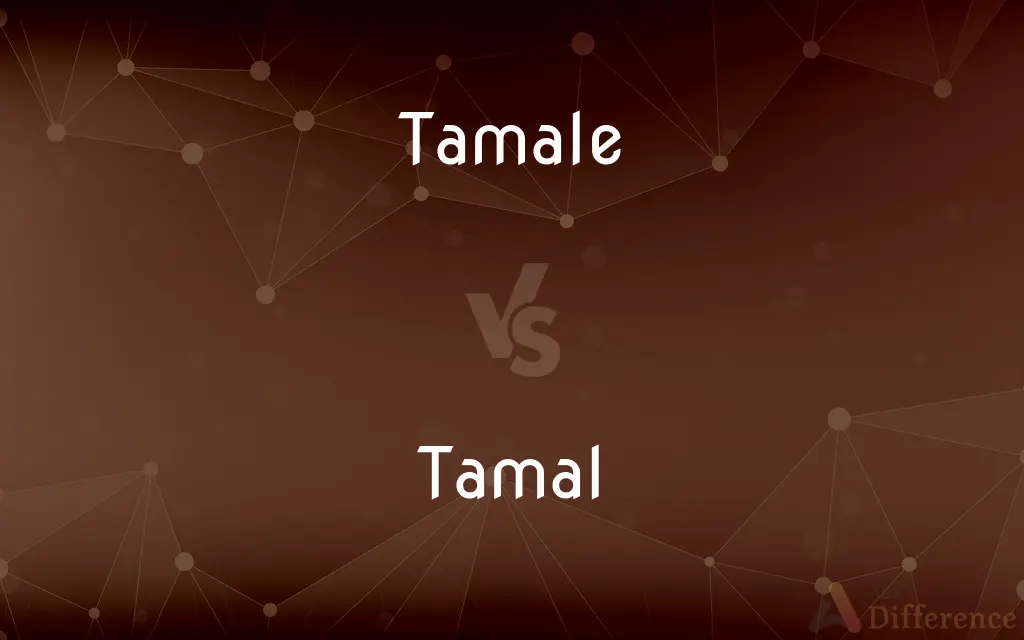Tamale vs. Tamal — What's the Difference?
Edited by Tayyaba Rehman — By Maham Liaqat — Updated on April 7, 2024
A tamale is a traditional Mesoamerican dish made of masa, wrapped in a corn husk, while a tamal refers to the singular form in Spanish.

Difference Between Tamale and Tamal
Table of Contents
ADVERTISEMENT
Key Differences
Tamale, a term widely used in English, refers to a Mesoamerican dish consisting of masa or dough, often filled with meats or vegetables, and steamed in a corn husk or banana leaf. On the other hand, tamal is the singular form of the word in Spanish, emphasizing the dish's cultural and linguistic origins.
While tamales are known for their diverse fillings, including pork, chicken, beef, and vegetarian options, seasoned with various sauces, tamal emphasizes the individual serving and preparation style within Latin American cuisines. This distinction highlights the dish's versatility and regional variations.
In English-speaking contexts, "tamale" is commonly used both for singular and plural forms, simplifying communication. Whereas, in Spanish, "tamal" for singular and "tamales" for plural maintain linguistic accuracy and respect for the dish's cultural significance.
The preparation of a tamale involves spreading masa on a corn husk, filling it, and folding it for steaming. Conversely, preparing a tamal follows the same method, underscoring the universal technique across different cultures while allowing for local adaptations and ingredient variations.
Tamales often feature in celebrations and gatherings, symbolizing communal effort and cultural heritage. Similarly, preparing and sharing a tamal is an act of cultural expression and familial bonding, highlighting the dish's role in social and cultural contexts.
ADVERTISEMENT
Comparison Chart
Definition
A traditional Mesoamerican dish made of masa, wrapped in a corn husk.
Singular form of 'tamales' in Spanish, referring to the same dish.
Language Usage
Commonly used in both singular and plural forms in English.
Used in Spanish to denote the singular form.
Cultural Significance
Symbolizes communal effort and heritage in gatherings.
Emphasizes individual preparation and cultural roots.
Preparation Technique
Involves spreading masa on a corn husk, adding fillings, and steaming.
Same technique, highlighting universal preparation across cultures.
Regional Variations
Known for diverse fillings and adaptations in different regions.
Focus on local ingredient variations and traditional methods.
Compare with Definitions
Tamale
Can be sweet or savory, depending on the filling.
For dessert, they served sweet tamales filled with pineapple.
Tamal
Integral to various Latin American cuisines.
Each region has its own unique tamal recipe.
Tamale
Often filled with meats, vegetables, or cheese.
She loves spicy chicken tamales with green sauce.
Tamal
Can be wrapped in corn husks or banana leaves.
She prefers tamales wrapped in banana leaves for the added flavor.
Tamale
A popular dish in Latin American celebrations.
Tamales are a must-have during the Christmas season in Mexico.
Tamal
Singular form of 'tamales' in Spanish, a steamed masa dish.
He ordered a tamal de pollo at the Mexican restaurant.
Tamale
Symbolizes communal cooking and tradition.
Making tamales together strengthens our family bond.
Tamal
Emphasizes the dish's cultural and linguistic roots.
Learning to make a traditional tamal was part of her culinary journey.
Tamale
A Mesoamerican dish made of masa steamed in a corn husk.
The family gathered to make pork tamales for the holiday.
Tamal
Reflects regional ingredient preferences and cooking styles.
In his hometown, a tamal is typically filled with local vegetables and sauces.
Tamale
A tamale or tamal is a traditional Mesoamerican dish, made of masa or dough (starchy, and usually corn-based), which is steamed in a corn husk or banana leaf. The wrapping can either be discarded prior to eating or used as a plate.
Tamal
Alternative form of tamale.
Tamale
A Mexican dish made of chopped meat and crushed peppers, highly seasoned, wrapped in cornhusks spread with masa, and steamed.
Tamale
Mexican dish of cornmeal dough shell filled with various ingredients (e.g. chopped beef, pork, sweet filling) then steamed in corn husks.
Tamale
A Mexican dish made of crushed corn (cornmeal) mixed with minced meat, seasoned with red pepper, dipped in oil, and steamed.
Tamale
Corn and cornmeal dough stuffed with a meat mixture then wrapped in corn husks and steamed
Common Curiosities
What is a tamale?
A traditional Mesoamerican dish made of masa, filled with meats or vegetables, and steamed in a corn husk or banana leaf.
Can tamales be vegetarian?
Yes, tamales can be filled with vegetables, cheese, or vegan fillings.
What does tamal mean?
Tamal is the singular form of 'tamales' in Spanish, referring to the same steamed masa dish.
How are tamales served?
Tamales are usually unwrapped from the corn husk or banana leaf and can be served with sauces or salsas.
Is there a sweet version of tamales?
Yes, there are sweet tamales filled with fruits, chocolate, or sweetened masa.
What's the difference between a tamale and a tamal?
The difference is primarily linguistic, with "tamale" used in English and "tamal" the singular form in Spanish.
Do all Latin American countries have their own version of tamales?
Yes, many Latin American countries have their own unique versions of tamales.
What occasions are tamales made for?
Tamales are often made for special occasions, holidays, and family gatherings.
Are tamales only made with corn husks?
No, tamales can also be wrapped in banana leaves, depending on the region and tradition.
How long does it take to make tamales?
Making tamales can be time-consuming, often taking several hours for preparation and steaming.
What's the significance of making tamales during Christmas in Mexico?
Making tamales during Christmas is a tradition that symbolizes family unity and celebration.
Are tamales gluten-free?
Yes, since they are made with masa harina (corn flour), tamales are naturally gluten-free.
Can tamales be frozen?
Yes, tamales can be frozen either before or after steaming and reheated later.
What is the origin of tamales?
Tamales date back to ancient Mesoamerica, where they were prepared by indigenous cultures.
Can tamales be made ahead of time?
Yes, tamales can be prepared in advance, making them ideal for large gatherings or celebrations.
Share Your Discovery

Previous Comparison
Wear vs. Ware
Next Comparison
Principle vs. TheoryAuthor Spotlight
Written by
Maham LiaqatEdited by
Tayyaba RehmanTayyaba Rehman is a distinguished writer, currently serving as a primary contributor to askdifference.com. As a researcher in semantics and etymology, Tayyaba's passion for the complexity of languages and their distinctions has found a perfect home on the platform. Tayyaba delves into the intricacies of language, distinguishing between commonly confused words and phrases, thereby providing clarity for readers worldwide.
















































